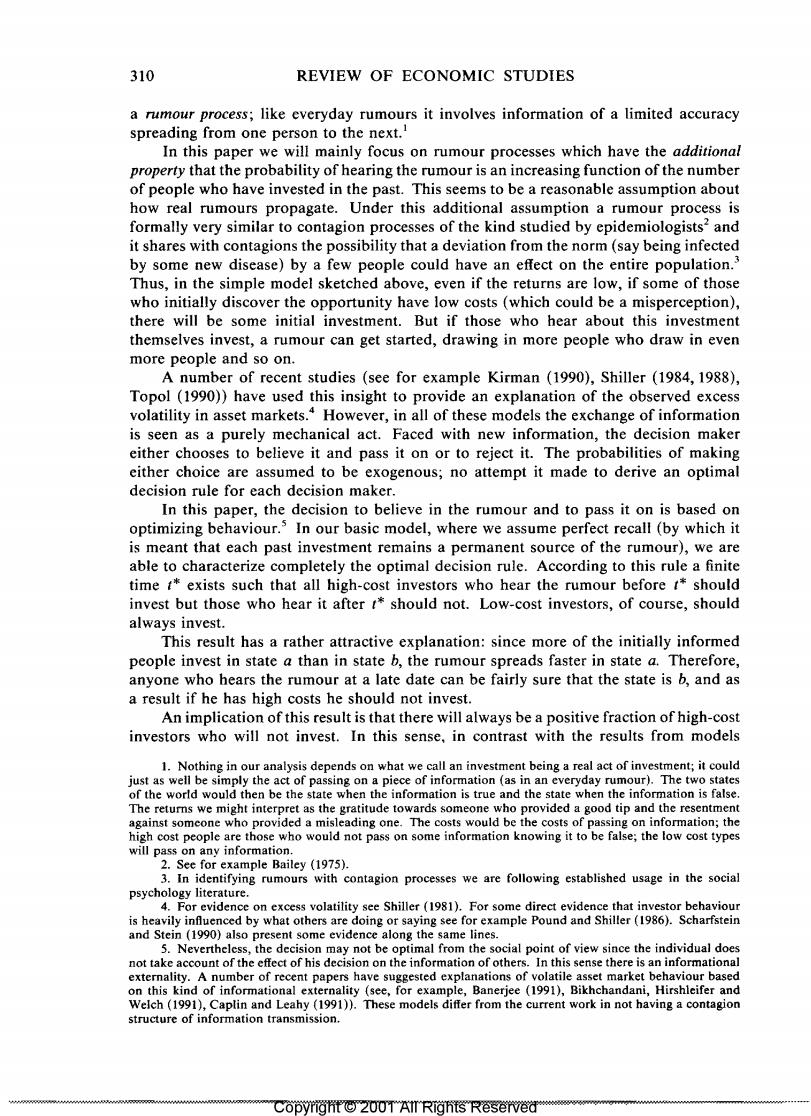正在加载图片...

310 REVIEW OF ECONOMIC STUDIES a rumour process;like everyday rumours it involves information of a limited accuracy spreading from one person to the next. In this paper we will mainly focus on rumour processes which have the additional property that the probability of hearing the rumour is an increasing function of the number of people who have invested in the past.This seems to be a reasonable assumption about how real rumours propagate.Under this additional assumption a rumour process is formally very similar to contagion processes of the kind studied by epidemiologists'and it shares with contagions the possibility that a deviation from the norm(say being infected by some new disease)by a few people could have an effect on the entire population.3 Thus,in the simple model sketched above,even if the returns are low,if some of those who initially discover the opportunity have low costs(which could be a misperception), there will be some initial investment.But if those who hear about this investment themselves invest,a rumour can get started,drawing in more people who draw in even more people and so on. A number of recent studies (see for example Kirman (1990),Shiller (1984,1988), Topol (1990))have used this insight to provide an explanation of the observed excess volatility in asset markets.However,in all of these models the exchange of information is seen as a purely mechanical act.Faced with new information,the decision maker either chooses to believe it and pass it on or to reject it.The probabilities of making either choice are assumed to be exogenous;no attempt it made to derive an optimal decision rule for each decision maker. In this paper,the decision to believe in the rumour and to pass it on is based on optimizing behaviour.3 In our basic model,where we assume perfect recall(by which it is meant that each past investment remains a permanent source of the rumour),we are able to characterize completely the optimal decision rule.According to this rule a finite time t*exists such that all high-cost investors who hear the rumour before t*should invest but those who hear it after t*should not.Low-cost investors,of course,should always invest. This result has a rather attractive explanation:since more of the initially informed people invest in state a than in state b,the rumour spreads faster in state a.Therefore, anyone who hears the rumour at a late date can be fairly sure that the state is b,and as a result if he has high costs he should not invest. An implication of this result is that there will always be a positive fraction of high-cost investors who will not invest.In this sense,in contrast with the results from models 1.Nothing in our analysis depends on what we call an investment being a real act of investment;it could just as well be simply the act of passing on a piece of information(as in an everyday rumour).The two states of the world would then be the state when the information is true and the state when the information is false. The returns we might interpret as the gratitude towards someone who provided a good tip and the resentment against someone who provided a misleading one.The costs would be the costs of passing on information;the high cost people are those who would not pass on some information knowing it to be false;the low cost types will pass on any information. 2.See for example Bailey (1975). 3.In identifying rumours with contagion processes we are following established usage in the social psychology literature. 4.For evidence on excess volatility see Shiller (1981).For some direct evidence that investor behaviour is heavily influenced by what others are doing or saying see for example Pound and Shiller(1986).Scharfstein and Stein (1990)also present some evidence along the same lines. 5.Nevertheless,the decision may not be optimal from the social point of view since the individual does not take account of the effect of his decision on the information of others.In this sense there is an informational externality.A number of recent papers have suggested explanations of volatile asset market behaviour based on this kind of informational externality (see,for example,Banerjee (1991),Bikhchandani,Hirshleifer and Welch(1991),Caplin and Leahy (1991)).These models differ from the current work in not having a contagion structure of information transmission. C6Dyri0it©200TA1TRI心fi搭RsěrvěT